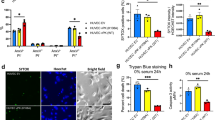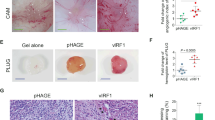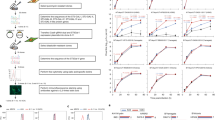Abstract
Kaposi's sarcoma-associated herpesvirus (KSHV), or human herpesvirus 8, is invariably present in Kaposi's sarcoma lesions1,2. KSHV contains several viral oncogenes and serological evidence suggests that KSHV infection is necessary for the development of Kaposi's sarcoma, but cellular transformation by this virus has not so far been demonstrated. KSHV is found in the microvascular endothelial cells in Kaposi's sarcoma lesions and in the spindle ‘tumour’ cells3,4, which are also thought to be of endothelial origin. Here we investigate the biological consequences of infecting human primary endothelial cells with purified KSHV particles. We find that infection causes long-term proliferation and survival of these cells, which are associated with the acquisition of telomerase activity and anchorage-independent growth. KSHV was present in only a subset of cells, and paracrine mechanisms were found to be responsible for the survival of uninfected cells. Their survival may have been mediated by upregulation of a receptor for vascular endothelial growth factor. Our results indicate that transformation of endothelial cells by KSHV, as well as paracrine mechanisms that are induced by this virus, may be critical in the pathogenesis of Kaposi's sarcoma.
This is a preview of subscription content, access via your institution
Access options
Subscribe to this journal
Receive 51 print issues and online access
$199.00 per year
only $3.90 per issue
Buy this article
- Purchase on Springer Link
- Instant access to full article PDF
Prices may be subject to local taxes which are calculated during checkout





Similar content being viewed by others
References
Chang, Y. et al. Identification of herpesvirus-like DNA sequences in AIDS-associated Kaposi's sarcoma. Science 266, 1865–1869 (1994).
Moore, P. S. & Chang, Y. Detection of herpesvirus-like DNA sequences in Kaposi's sarcoma in patients with and those without HIV infection. N. Engl. J. Med. 332, 1181–1185 (1995).
Boshoff, C. et al. Kaposi's sarcoma-associated herpesvirus infects endothelial and spindle cells. Nature Med. 1, 1274–1278 (1995).
Reed, J. A. et al. Demonstration of Kaposi's sarcoma-associated herpesvirus cyclin D homolog in cutaneous Kaposi's sarcoma by colorimetric in situ hybridization using a catalyzed signal amplification system. Blood(in the press).
Arvanitakis, L. et al. Establishment and characterization of a primary effusion (body cavity-based) lymphoma cell line (BC-3) harboring Kaposi's sarcoma-associated herpesvirus (KSHV/HHV-8) in the absence of Epstein–Barr virus. Blood 88, 2648–2654 (1996).
Renne, R. et al. Lytic growth of Kaposi's sarcoma-associated herpesvirus (human herpesvirus 8) in culture. Nature Med. 2, 342–346 (1996).
Miller, G. et al. Selective switch between latency and lytic replication of Kaposi's sarcoma herpesvirus and Epstein–Barr virus in dually infected body cavity lymphoma cells. J. Virol. 71, 314–324 (1997).
Rafii, S. et al. Human bone marrow microvascular endothelial support long term proliferation and differentiation of myeloid and megakaryocytic progenitors. Blood 86, 3353–3363 (1995).
Watanabe, Y. & Dvorak, H. F. Vascular permeability factor/vascular endothelial growth factor inhibits anchorage-disruption-induced aposptosis in microvessel endothelial cells by inducing scaffold formation. Exp. Cell Res. 233, 340–349 (1997).
Cesarman, E. et al. Kaposi's sarcoma associated herpesvirus (KSHV/HHV-8) contains G protein-coupled receptor and cyclin D homologs which are expressed in Kaposi's sarcoma and malignant lymphoma. J. Virol. 70, 8218–8223 (1996).
O'Leary, J. PCR In-situ Hybridization. 1–53-86 (IRL, Oxford University Press, Oxford, (1997)).
Ruby Chan, S., Bloomer, C. & Chandran, B. Identification and characterization of human herpesvirus-8 lytic cycle associated ORF 59 protein and the encoding cDNA by monoclonal antibody. Virology 240, 118–126 (1998).
Hewett, P. W. & Murray, J. C. Coexpression of flt-1, flt-4 and KDR in freshly isolated and cultured human endothelial cells. Biochem. Biophys. Res. Commun. 221, 697–702 (1996).
Rienke, U., Burlington, H., Cronkite, E. P. & Laissue, J. Hayflick's hypothesis: an approach to in vivo testing. Fed. Proc. 34, 71–75 (1975).
Kim, N. W. et al. Specific association of human telomerase activity with immortal cells and cancer. Science 266, 2011–2015 (1994).
Mieczyslaw, A. P. et al. Detection of telomerase activity in human cells and tumors by a telomeric repeat amplification protocol (TRAP). Meth. Cell Sci. 17, 1–15 (1995).
Kennedy, M. M. et al. HHV8 and Kaposi's sarcoma: a time cohort study. Mol. Pathol. 50, 96–100 (1997).
Rhoads, R. E. Optimization of the annealing temperature for DNA amplification in vitro. Nucleic Acids Res. 18, 6409–6412 (1990).
Kedes, D. H. et al. The seroepidemiology of human herpesvirus 8 (Kaposi's sarcoma-associated herpesvirus): Distribution of infection in KS risk groups and evidence for sexual transmission. Nature Med. 2, 918–924 (1996).
Kim, N. W. & Wu, F. Advances in quantification and characterization of telomerase activity by the telomeric repeat amplification protocol (TRAP). Nucleic Acids Res. 25, 2595–2597 (1997).
Acknowledgements
We thank S. Chen-Kiang, D. Knowles, M. C. Gershengorn and E. Mesri for their suggestions; B. Chandran and S.-J. Gao for antibodies against lytic antigens; P. Pellet for positive controls CMB and HHV-6; L. Friedman, S. Nikolovska, B. Ferris, G. Lam, A. J. Naiyer, S. Diana, I. Silva and V.Uhlmann for technical help; and S. Picton and K. Lohman at Perkin Elmer Applied Biosystems.
Author information
Authors and Affiliations
Corresponding author
Supplementary Information
Rights and permissions
About this article
Cite this article
Flore, O., Rafii, S., Ely, S. et al. Transformation of primary human endothelial cells by Kaposi's sarcoma-associated herpesvirus. Nature 394, 588–592 (1998). https://doi.org/10.1038/29093
Received:
Accepted:
Issue Date:
DOI: https://doi.org/10.1038/29093
This article is cited by
-
Towards Better Understanding of KSHV Life Cycle: from Transcription and Posttranscriptional Regulations to Pathogenesis
Virologica Sinica (2019)
-
The effects of antiviral treatment on breast cancer cell line
Infectious Agents and Cancer (2017)
-
Kaposi sarcoma-associated herpesvirus promotes tumorigenesis by modulating the Hippo pathway
Oncogene (2015)
-
Recent advances in the study of Kaposi’s sarcoma-associated herpesvirus replication and pathogenesis
Virologica Sinica (2015)
Comments
By submitting a comment you agree to abide by our Terms and Community Guidelines. If you find something abusive or that does not comply with our terms or guidelines please flag it as inappropriate.



